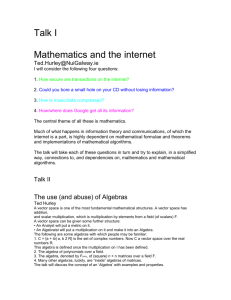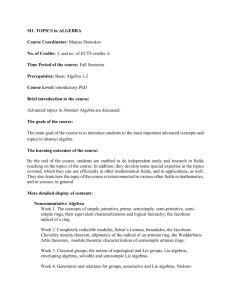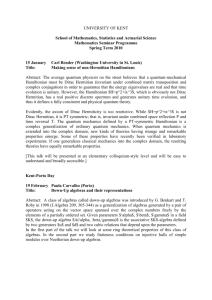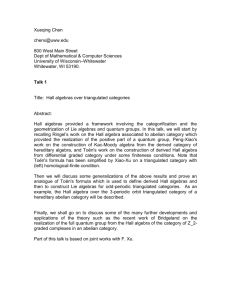GEOMETRY/PHYSICS SEMINAR JOHN HUERTA UC RIVERSIDE 1
advertisement
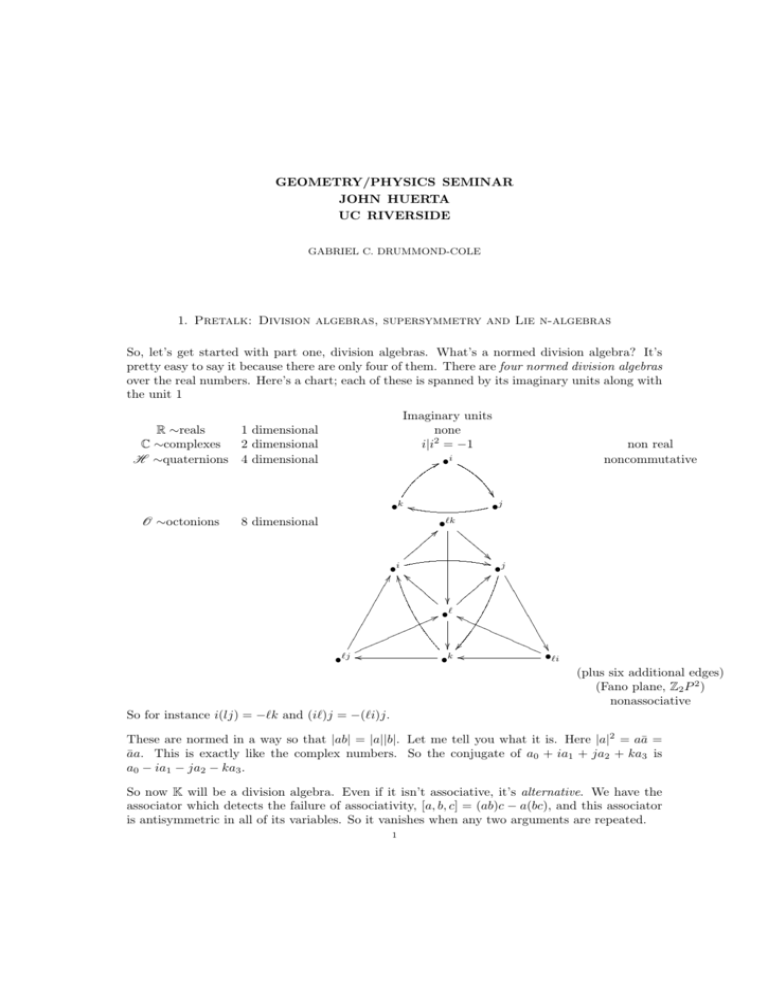
GEOMETRY/PHYSICS SEMINAR
JOHN HUERTA
UC RIVERSIDE
GABRIEL C. DRUMMOND-COLE
1. Pretalk: Division algebras, supersymmetry and Lie n-algebras
So, let’s get started with part one, division algebras. What’s a normed division algebra? It’s
pretty easy to say it because there are only four of them. There are four normed division algebras
over the real numbers. Here’s a chart; each of these is spanned by its imaginary units along with
the unit 1
R ∼reals
C ∼complexes
H ∼quaternions
Imaginary units
none
i|i2 = −1
7 •i
1 dimensional
2 dimensional
4 dimensional
•k k
O ∼octonions
8 dimensional
non real
noncommutative
•j
`k
> • AA
}
AA
}
AA
}}
}
AA
}
}}
+ j
•G iS `A
> • 00
A
}
AA
}
00
}
AA
}
00
AA
}}
}}
00
`
00
7 • gPPP
n
n
PPP
00
nn
n
P
n
PPP
0
nn
n
n
P
n
PPP 00
nnnn
P •`i
•`j o
•k o
(plus six additional edges)
(Fano plane, Z2 P 2 )
nonassociative
So for instance i(lj) = −`k and (i`)j = −(`i)j.
These are normed in a way so that |ab| = |a||b|. Let me tell you what it is. Here |a|2 = aā =
āa. This is exactly like the complex numbers. So the conjugate of a0 + ia1 + ja2 + ka3 is
a0 − ia1 − ja2 − ka3 .
So now K will be a division algebra. Even if it isn’t associative, it’s alternative. We have the
associator which detects the failure of associativity, [a, b, c] = (ab)c − a(bc), and this associator
is antisymmetric in all of its variables. So it vanishes when any two arguments are repeated.
1
2
GABRIEL C. DRUMMOND-COLE
So, any triple product of two things associates. So (aa)b = a(ab) and a(ba) = (ab)a and
b(aa) = (ba)a, and by a theorem of Artin, an alternative algebra can be defined as one where
any two elements generate an associative algebra. That sounds obvious but proving it is a pain
in the ass. You have to worry about multiple products, and all of the parenthesizations.
So what are the division algebras good for? I’ll show you one thing they’re good for later today,
discussing supersymmetry. One thing that they are good for is describing rotations, thanks to
being normed, for example, when you take Rθ (z) = eiθz . But not everyone knows that when
you multiply an imaginary quaternion by a unit quaternion on one side and its conjugate on the
−uθ
uθ
other side you get rotation by θ, Rθ (~v ) = e 2 ~v e 2 (about the u-axis, where ~v is an imaginary
3
quaternion (so in R ) and û is an imaginary unit quaternion. euθ = cos θ + û sin θ, and you get
all of SO(3) in this way. Computer programmers like to represent rotations like this. Similarly,
multiplying elements in the octonions by unit elements, Ru (z) = uz is not a group because it’s
nonassociative, but it is a rotation because of the norm and generates all of SO(8). A good
exercise is checking this formula for the quaternions.
To get SO(4), what you do, I’ll use a unit quaternion, I’ll use an arbitrary quaternion, R(u,v) (q) =
uqv̄ where u and v are unit quaternions. This is a famous isomorphism actually that SU (2) =
{all unit quaternions} and SO(4) ∼
= SU (2) × SU (2) (sort of, exactly on the level of Lie algebras,
one is the double cover of the other)
That’s a famous fact, and that kind of leads into the next topic, I said the next topic would be
supersymmetry, and I lied, it’ll actually be Clifford algebras. To understand supersymmetry you
need to understand spinors, and to understand those you have to understand Clifford algebras
and Spin groups (double covers of SO groups)
So there’s, the study of Clifford algebras generalizes quaternions and are also called geometric
algebras. Even though they’re algebras, they’re also very geometric, I’ll tell you why. You take
a vector space v with inner product h , i or an associated norm || · ||2 or any nondegenerate
symmetric form. Then Clif f (V ), in terse terms, is the free associative algebra T V modulo the
relation that v 2 = ||v||2 (sometimes people put a minus sign there) or equivalently T V /(vw+wv =
2hv, wi). You get one relation from the other by polarizing. I’ll say in words what this means,
so it ends up in the notes. Clif f (V ) is the free(est) algebra on V such that that the square is
the norm or equivalently vw + wv = 2hv, wi. Why is this so great?
Well, remember, with quaternions we got rotations on R3 with the Rθ (~v ) = eθu/2~v (eθu/2 )−1 ; in
the Clifford algebra, we also get something by doing this sort of conjugation by a unit vector
and its inverse (I’ll throw in a − sign): Ru (v) = −uvu−1
u
Here uu−1 = 1 so u−1 = ||u||
. When you’re a unit vector, ||u|| = 1 (later sometimes −1 if
the norm is not positive definite) so uu = 1. So Ru (v) = −uvu. Then I can use the relation
uv + vu = 2hu, vi and when I do that I introduce a minus sign uv = −vu + 2hu, vi. Then I
get −uvu = (vu − 2hu, vi)u = vu2 − 2hu, viu = v − 2hu, viu. Do you recognize that formula?
That’s a reflection about the line orthogonal to u [sic]. I’ll suggestively call this Ru (v), and that
involves the same perpendicular part but the opposite parallel part.
When I subtract this out, the new thing is the original v minus twice the parallel part, which
is just like in 2-dimensional geometry, hu, viu. As we just saw, that’s uvu−1 (or the negative of
it). So we can get reflections in the Clifford algebra in a pretty straightforward way using units
in the Clifford algebra. I apologize if writing this out makes it tedious but I’m hoping it lands
GEOMETRY/PHYSICS SEMINAR
JOHN HUERTA
UC RIVERSIDE
3
in the notes—just to make the notes better. Consider P in(V ), the set of unit vectors in V , it’s
a subset of the Clifford algebra and it’s a multiplicative group. By extending the action Ru (v),
we turn elements of P in(V ) into reflections and rotations. That is, we get an action of P in(V )
on V that preserves the norm, so we get a map P in(V ) → O(V ).
I’m almost out of time, but let me finish by saying what Spin(V ) and spinors are. So what
about when you compose two reflections? [picture] This ends up being rotation by 2θ if the axes
differ by θ. So when you compose two reflections you get a rotation. SO is more important than
O, so I should focus on pairs of unit vectors, which give me rotations, just like that. It’s weird
how the blue [chalk] doesn’t erase.
Then consider Spin(V ) which is the group generated by products of pairs of unit vectors. It’s
a subgroup of P in(V ) sitting in Clif f (V ). Restricting ϕ : P in(V ) → O(V ) to Spin(V ) lands
in SO(V ), rotations. In fact, they give all rotations, so this map is onto, ϕ is onto. So by
basic algebra, Spin(V )/ ker ϕ ∼
= SO(V ). Now so what’s the kernel? In fact, the kernel of
ϕ is Z2 , since the unit vectors u and v give the same reflection as −uv, and that’s the only
redundancy. So this is the double cover, you’re modding out, cutting it in half with that Z2 .
So Spin(V ) is the double cover, and the strange property of double covers, it has the same
Lie algebra, Lie(Spin(V )) = so(V ) but it has more representations than SO(V ). It has spinor
representations. These are representations coming from left modules (or right modules), I’ll say
modules of Clif f (V ). That’s the main thing you need to know about spinors, that they come
from such modules. People often mean irreducible modules that arise in this way but I mean
something more general.
[Can you give me an example?]
Spin(V ) is a subgroup of P in(V ) which is a subset of Clif f (V ) (it generates Clif f (V ) as a set)
and so, given module S of Clif f (V ), you can take an element S and multiply them by Clif f (V )
elements and in particular, multiply by Spin(V ) elements. That gets Spin(V ) to act on S. This
was a big revelation to me, when I realized that when physicists talk about spinors they take
g ∈ Spin(V ), which they call SO(V ) and you act on v by conjugating v 7→ gvg −1 and you act
on spinors ψ by left multiplication ψ 7→ gψ.
I’m out of time. I didn’t get to talk about Lie-n algebras at all but I’ll do it during the normal
talk.
2. Seminar: Division algebras, supersymmetry and Lie n-algebras
[I do not take full notes during slide talks].
Thanks, I’m a grad student at UC riverside. I’ve been studying the connection between division
algebras and supersymmtery, and this leads into higher gauge theory.
It starts with the puzzle, that you only have 4 division algebras that are dimensions k = 1, 2,
4, and 8. The classical superstring theory makes sense only in dimensions k + 2. Think of a
string sweeping out a world sheet in time, so a two dimensional thing. A 2-brane is a surface
doing this sweeping out a volume, and the super 2-brane only makes sense in dimensions k + 3.
Pulling this thread will take us into higher gauge theory.
4
GABRIEL C. DRUMMOND-COLE
Gauge theory says the electromagnetic field A is a connection on a U (1) bundle. We’ll combine
this with supersymmetry that says there is a Z2 grading throughout. This is actually quite rich
and interesting. So string and M -theory have deep conncetions with geometry. The B field
in string theory is a connection on a U (1) gerbe, the C-field in M -theory is a connection on a
U (1)-2-gerbe. These generalize the A field which is a connection on a U (1)-bundle. I like to think
of a gerbe as a bundle whose fibers instead of spaces are categories. You replace some of your
structures with categories. So what I mean by the B field being a U (1)-gerbe is that locally it’s
a 2–form but globally has nontrivial transition data on double and triple intersections. Locally
the C-field is a 3-form with global nontrivial transition data on double, triple and quadruple
intersections (just as the A-field has nontrivial transition data on just double intersections). The
physical idea is that particles
sweep out worldlines and interact with A by integrating them
R
along that world line γ A(γ). Similarly strings sweep out worldsheets and you can integrate
them along the local 2-form B, and similarly 2-branes sweep out world volumes and you integrate
them against the local 3-form C. So B and C fields are like connections. We can generalize the
definition of connection. This is due to Sati, Schreiber, and Stasheff, who generalized connections
to something valued in L∞ algebras.
To review, an L∞ is roughly a Lie algebra defined on a chain complex L0 ← L1 ← · · · ←
Ln ← · · · satisfying the Lie algebra axioms up to chain homotopy. So the Jacobi identity
[x, [y, z]] + cyclic is chain homotopic to 0. More precisely, an L∞ algebra is a graded vector
space with a system of graded antisymmetric linear maps satisfying a generalization of the Jacobi
identity. It has a boundary operator δ making it a chain complex, a bilinear bracket [−, −] like
a Lie algebra, and higher brackets. [Brief description of the relations]
We can just as easily consider L∞ superalgebras. We introduce additional signs for odd elements.
Connections valued in certain L∞ superalgebras describe parallel transport in the appropriate
dimension. In grading 1, suprestring(V ) is R and in grading 0 it’s siso(V ) which I’ll describe.
So this gives an R-valued 2-form, the B field, and a siso(V )-valued 1-form, and [unintelligible],
that’s the Levi-Civita connection. You should think it’s something like, well, I’ll define it later,
but I’d rather tell you now. You know what so(V ) is, and so(V ) n V is called iso(V ) and siso(V )
is rotations, translations ,and supertranslations, so(V ) n (V ⊕ S).
Similarly, everything for string theory works for brane theory, you get R in degree 2 and in
degree 2 you get siso(V ) the Levi-Civita connection.
Our goal is not to talk about all the higher gauge theory but just construct these L∞ algebras.
Since they only involve 2 and 3 terms we’ll call them Lie2 and Lie3 algebras. So superstrings
and super 2-branes are exceptional, only making sense in certain dimensions. The corresponding
Lie 2 and Lie 3 superalgebras are similarly exceptional. So for instance, G2 are automorphisms
of the octonions.
Let’s talk about how string and membrane theory are related to division algebras. If you look
at what coincidences need to occur for the theory to make sense. For superstring we have
[ψ, ψ]ψ = 0 for all spinors. In the pretalk, I said, you have a vector space V with a nondegenerate
form || · ||2 . You have Clif f (V ) = T V /v 2 = ||v||2 . Inside this you can find Spin(V ), isomorphic
to the universal cover of SO(V ), which acts on left-modules of the Clifford algebra. You get a
group action, and these are spinor representations.
GEOMETRY/PHYSICS SEMINAR
JOHN HUERTA
UC RIVERSIDE
5
In dimensions 3, 4, 6 and 10 we have the bracket from spinors to tensors, and in the Clifford
algebra, you can take the vector, act on the original spinor and get 0. This is the identity you
need for superstrings to work.
Physicists say it’s necessary for the Green Schwarz Lagrangian to have κ-symmetry to cut down
the symmetries to bosonic symmetry. Fermions are described with spinors, bosons with vectors,
and you need to match them up.
So, this is the stuff I wrote on the board. V is like a spacetime.
The spinor representations are defined using division algebras, and that’s the trick. Similarly
for the 2-brane, you have a different rule: [ψ, [ψ, ψ]ψ] = 0.
So, where do the division algebras come in? We can use K to build V and S in superstring and V
and S in super-2-brane. If you’ve ever heard that 2 × 2 Hermitian matrices are related to special
relativity, this is how, the determinant is the norm. You get the usual sign, −t2 . You have for
your spinors K2 , and then the Clifford action is matrix multiplication. With the octonions put
the parentheses
as far to the right as possible. Then [ψ, ψ] = 2ψ ψ̄ T − 2ψ̄ T ψ1 ∈ V . You take
ψ1
the conjugate transpose ψ̄1 ψ̄2 , multiply those together, you get a matrix, and you
ψ2
need to change the trace of the matrix by subtracting off, well, I won’t write it. Thes showing
that [ψ, ψ]ψ = 0 is an easy exercise. This is (ψ ψ̄ T − ψ̄ T ψ)ψ, and you can move things around.
There’s a tiny problem in the octonions, which are not associative, but they’re alternative,
meaning everything with only two things in it is associative.
In Lawson Michelson, whenever you have a pairing h , i : S ×S → R and let g([ψ, φ], v) = hψ, vφi.
This is a very natural way to define this that doesn’t involve mucking about with division
algebras.
These constructions are due to Sudbery, Manogue, Dray, and Schray, for 3, 4, 6, 10 and we’ve
done it for 2-branes for 4, 5, 7, 11. What are the rules? They are cocycle conditions. There’s a
3-cochain α and the relation is that dα = 0. This is in Lie superalgebra cohomology. You take
a Lie algebra, it has a bracket ∧2 g → g, and you get a cochain complex ∧0 g∗ → ∧1 g∗ → ∧2 g∗ .
The d is dual to the bracket, extended by Leibniz.
In 3, 4, 6, 10 you get a Lie superalgebra V ⊕ S with the bracket Sym2 S → V and α is a 3-cocycle.
In 3, 4, 6, 10 we can extend to siso(V ) and up one dimension we can extend β to a cocycle on
sisoV (the Poincaré algebras)
What are α and β good for? Building Lie n-superalgebras. The n-term comlex with g in degree 0
and R in degree n. We call this the extension of g by ω. We have the Lie 2 and 3-superalgebras
superstring(V ) and 2 − brane(V ). There are Lie 2-supergroups and Lie 3-supergroups corresponding. Usually you would get horrible things integrating a Lie algebra but these are finite
dimensional.
[Are the 2-branes physically relevant? ] If you think M -theory is physically relevant, then yes.
[How is the Lie n-stuff related to higher connection pieces?]
ln a gerbe you have 2-forms and on an overlap you need Bi − Bj = daij , and those guys
have to satisfy an identity where I won’t get the indices right, a triple identity, something like
6
GABRIEL C. DRUMMOND-COLE
aij + ajk = aik + h−1
ijk dhijk where hijk are functions (0-forms) on triple overlaps on Ui ∩ Uj ∩ Uk .
More than giving the definition I’m not sure what to do.
[Kevin: [missed question and answer]]
[When I think of connections I think of parellel translation.] Levi-Civita is about parallel transport, but on another bundle it tells you how to get from one to another. To think of parallel
transport of, so, for example, in the A-field case, your fibers look like circles, U (1), and the connection tells you how to twist your circle. When you translate your string, you have an element
of U (1) over each path, and you learn how to twist that. People sometimes say that this is a
U (1) bundle on the loop group. You look at the loop group and then you associate U (1) fibers
to each loop.
